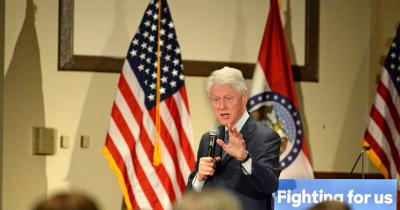
Owning the Consequences: Clinton and the Repeal of Glass-Steagall
Here is why Bill Clinton’s simply wrong.

The 2008 financial crisis was no accident. It was the result of a decades-long deregulation effort, lobbied for by the financial industry and executed by our political institutions. Now, as the facts of the financial collapse fade from memory, some would rather rewrite their part in history than keep history from repeating itself.
The other day, Bill Clinton was asked why politicians often pay lip service to the need to regulate finance and business, but nothing ever seems to happen. His response:
I'll tell you exactly why. I think that politicians—particularly now, in the aftermath of this crash—fear that anything they do will be held against them later if anything bad happens. Look at all the grief I got for signing the bill that ended Glass-Steagall. There's not a single, solitary example that it had anything to do with the financial crash. And in fact, a study done afterward said that the unified banks were actually slightly less likely to fail than either the commercial banks that overloaded on subprime mortgages, or the investment banks, like Bear Stearns, Lehman Brothers, and others.
The former President and I lived through the Glass-Steagall debate. And his statement is flat wrong. The Graham-Leach-Bliley Act that President Clinton signed had everything to do with the crisis.
Early in my career, I was a Wall Street lawyer. One of my firm’s clients was the Securities Industry Association (SIA), which pushed the agenda of the investment banks in Washington and New York and fought to preserve Glass-Steagall in the 1980s. I was the associate that had the job of researching and writing to support the effort.
Lawmakers originally intended Glass-Steagall to separate commercial banks, which accepted deposits, made loans, and were insured by the FDIC, and investment banks, which brought securities issues to markets, acted as brokers, and traded those securities previously issued. But that separation had been eroding for years. Why? Commercial banks wanted to get into the underwriting and trading businesses so that they could use the low-cost funds afforded them by the FDIC insurance to compete with the investment banks for business with this built-in advantage.
This was exactly what Glass-Steagall was enacted to prevent. Today, most people don't make the connection that Glass-Steagall both created FDIC insurance and separated commercial and investment banks. The connection of federal insurance and trading was fundamental to Glass-Steagall. Investment banks rightly argued that mixing FDIC insurance and trading was a bad idea because the insurance involved the US government in the inherently risky securities business.
The Office of the Comptroller of the Currency, whose bureaucracy had earned the reputation as the most “captured” of all regulators, administered the separation portion. During the 1970s and 80s the commercial banks had gotten approval for a host of absurd exceptions to the law, but they wanted more.
The real push to repeal the separation was in the 1990s. By then I worked as a banker for Bob Downey, who ran the Goldman Sachs Municipal Bond Department and was a major player in the SIA’s resistance to repeal. We’d worked together when I was an attorney. The prospects of repeal had been increasing for years. To avoid being run over by the plentiful and cheap capital available to the commercial banks, investment banks had to change their capital structures.
During the 1970s and early 1980s, they had prospered as partnerships in which the owners’ capital was at risk every trading day. Indeed, this was a fine system for moderating risk taking in the capital markets. But in response to the probable repeal, increasingly investment banks sold themselves to the market, raising outside capital, sometimes from foreign financial institutions but ultimately in big public offerings. They also began a process of merger to get bigger to weather the competition.
Ultimately, the investment banks cut a deal and the inevitable happened as the separation was repealed in November 1999 as President Clinton signed the Graham-Leach-Bliley Act. Roughly 9 years later, the crisis occurred, turning a recession into the worst economic event since the Great Depression.
Here is why Bill Clinton’s simply wrong.
The financial crisis occurred because banks involved in trading had become massive, concentrated and interconnected in response to the repeal of Glass-Steagall’s separation. It makes no difference that Bear Stearns and Lehman were not actually universal banks (meaning both commercial and investment). The point was that they were enormous and completely tied into the other big banks.
There were only five notable investment banks left in early 2008. Of those, two went down, a third (Merrill Lynch) survived only by a forced merger into Bank of America, and the fourth and fifth—Goldman and Morgan Stanley—were threatened with failure when they were converted overnight to universal banks. Converting to universal banks qualified them for FDIC insurance and the implicit support of the US government.
The big universal banks were directly in the path of the financial crisis and would not have survived without the TARP bailout (provided with no strings attached) and dozens of other supports from the Fed and Treasury.
Of course, as Clinton said, the “unified” banks were slightly less likely to fail because they were connected to the US Treasury indirectly through FDIC insurance. However, the real question was whether failure of any individual banks of certain significance could potentially trigger a systemic failure, dragging down all banks.
That was exactly what happened in 2008. It was a direct result of the massive increase in the size, concentration and interconnectedness of financial institutions as a consequence of the Graham-Leach-Bliley Act. The former President did many fine things, but signing that Act was not one of them.




